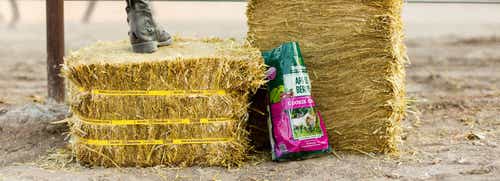
Feeding the Performance Horse
What makes a horse a performance horse? Performance is “loosely” defined as any form of work or forced physical activity. Work or physical activity can include walking, trotting, cantering, running, jumping, and turning. Therefore, a performance horses can include any horse that is actively ridden, trained or that may carry or pull a load. With this broad definition of performance, many of us have horses that are considered performance horses. Since the performance activities of horses vary in both duration and intensity, feeding systems to address the nutrient requirements of these horses must also vary. In the following article, we will begin to talk about feeding performance horses by addressing water and energy needs.
Each and every performance horse requires five key needs:
Nutritionists and horse owners spend a great deal of time and effort balancing the diet for energy, protein, vitamins and minerals; however, water is the single most important nutrient. Small decreases in the amount of water contained within the body (dehydration) can lead to serious health consequences, as well as a decline in performance potential. Performance horses must maintain proper hydration to transport materials to and from the cells within the body, and to synthesize and repair body tissues. The amount of water required by a performance horse depends on the amount of water lost from the body and the amount of water utilized for synthesis of protein. For performance horses, water is lost from the body primarily in sweat, urine, and feces. To replace the water lost from the body, performance horses should have free access to fresh, clean water. Important to note: Ice cold water should be avoided for horses still hot and sweaty from exercise, since cold water may cause shock to their system.

Of the remaining nutrients required by performance horses, energy is the dietary factor most influenced by work or exercise performance. Simply stated, the more work a horse performs, the more energy (calories) required to fuel that work. In a sense, performance horses are like automobiles; the more we drive and the faster we drive, the more fuel that is utilized. Horses derive energy from the feeds they consume. Hay, pasture, grain concentrates and certain supplements contain energy (calories) that horses can metabolize and use to generate mechanical energy for muscle movement.
Within feed, there are four constituents that can be metabolized to produce mechanical energy:
- Starch
- Fat
- Protein
- Fiber
Starch
Starch is a carbohydrate that can be broken down within the small intestine of the horse to form glucose, a simple sugar. Glucose is absorbed from the digestive system and can be metabolized immediately to produce energy, or it can be stored as energy within the body in the form of muscle or liver glycogen (sugar), or as body fat. The main source of starch in a performance horse diet is cereal grain (oats, corn or barley). Since the digestive system of a horse is designed primarily to digest fiber and has a limited capacity to digest starch, there is a restriction to the amount of grain that can be fed to performance horses. If too much grain is fed in a single meal (more than 5 lbs. of grain/meal/1000 lb. horse) this grain will not be properly digested in the small intestine and may result in digestive upset (colic) or laminitis as it travels further down the digestive tract (1). For this reason, other sources of energy (fat, protein and fiber) are also incorporated into a performance horse diet.
Fat
Fat is commonly added to the diets of performance horses. Liquid vegetable oil (corn and soybean oil), flax, and rice bran are several fat sources commonly utilized as energy sources for performance horses. Fat is an extremely useful energy source for several reasons. First, vegetable oil is well digested (>90%) by horses. Dietary fat is commonly added to commercial grain concentrates intended for performance horses. It is common for performance horse feeds to have between 6 and 12% fat.
Protein
The National Research Council (NRC, 2007) estimates the crude protein requirement for mature performance horses at 9-11%, depending on work intensity. Protein that is fed in excess of a performance horses’ requirement, can be broken down and utilized for energy. Unfortunately, the use of protein for energy requires the horse to excrete the nitrogen associated with the protein. Excretion of nitrogen requires the horse to drink more water and increases blood ammonia; both situations that are undesirable for performance horses. Thus, feeding excess protein as a source of energy is not a sound nutrition practice.
Fiber
The most overlooked source of energy for a performance horse is dietary fiber. The digestive system of the horse is designed to digest fiber, and hay and pasture can provide an extensive amount of energy for the performance horse. In fact, for the digestive system to function correctly, horses require at least 1.25% of their body weight in hay/pasture per day (1). Since the fermentation of fiber is slow and continues constantly, horses get an uninterrupted supply of energy throughout the day. The use of fiber as an energy source has evolved in recent years. Today, in addition to good quality hay and pasture, we have so-called super fibers that are safe to feed like hay but have the energy equivalent of oats. Examples of super fibers utilized in horse feed include beet pulp, a product of the sugar industry, and soybean seed coats, a product of the soybean industry.

In summary, we begin feeding performance horses by providing free-access to fresh, clean water. The next step is to provide adequate energy, but how do we determine how much energy they require? Energy is the only dietary factor that you can visually determine dietary adequacy. If you are feeding too much energy (too many calories), the horse gains weight or becomes fat; on the other hand, if you don’t feed enough energy (too few calories) the horse becomes thin or loses weight. You can’t simply look at horses and determine the status of other critical nutrients. Therefore, if your performance horse is too thin or too fat, it is your responsibility since we have the ability to offer more, or less, feed to properly balance energy requirements. To provide energy to the performance horse, we begin with feeding good quality forage (pasture/hay) and add additional energy with the use of a combination of starch, fat and super-fibers.
By Dr. Tania Cubitt & Dr. Stephen Duren
Standlee Nutritional Experts - Performance Horse Nutrition
References:
1. National Research Council. 2007. Nutrient Requirements of Horses: Sixth Revised Edition. Washington, DC: The National Academies Press. https://doi.org/10.17226/11653.














